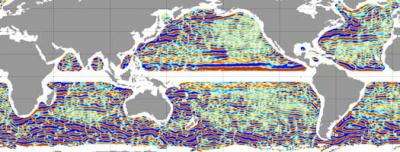Scientists reveal presence of ocean current 'stripes'

An international collaborative of scientists led by Peter Niiler, a physical oceanographer at Scripps Institution of Oceanography, UC San Diego, and Nikolai Maximenko, a researcher at the International Pacific Research Center, University of Hawaii, has detected the presence of crisscrossing patterns of currents running throughout the world’s oceans. The new data could help scientists significantly improve high-resolution models that help them understand trends in climate and marine ecosystems.
The basic dimensions of these steady patterns called striations have slowly been revealed over the course of several research papers by Niiler, Maximenko and colleagues. An analysis by Maximenko, Niiler and colleagues appearing today in the journal Geophysical Research Letters has produced the clearest representation of these striated patterns in the eastern Pacific Ocean to date and revealed that these complex patterns of currents extend from the surface to at least depths of 700 meters (2,300 feet). The discovery of similarly detailed patterns around the world is expected to emerge from future research.
Niiler credits the long-term and comprehensive ocean current measurements made over more than 20 years by the Global Drifter Program, now a network of more than 1,300 drifting buoys designed by him and administered by the National Oceanic and Atmospheric Administration (NOAA) for detecting these new current patterns on a global basis. Niiler added that the foresight of the University of California to provide long-term support to scientists was crucial to the discovery.
“I’m most grateful to the University of California for helping to support the invention and the 20-year maintenance of a comprehensive program of ocean circulation measurements,” he said. “Scripps Institution of Oceanography is unique because of its commitment to long-term observations of the climate. Instrumental measurements of the ocean are fundamental to the definition of the state of the climate today and improvement of its prediction into the future.”
In portions of the Southern Ocean, these striations—also known as ocean fronts—produce alternating eastward and westward accelerations of circulation and portions of them nearly circumnavigate Antarctica. These striations also delineate the ocean regions where uptake of carbon dioxide is greatest. In the Atlantic Ocean, these flows bear a strong association to the Azores Current along which water flowing south from the North Atlantic circulation is being subducted. The spatial high-resolution view of the linkage between the striations and the larger scale patterns of currents could improve predictions of ocean temperatures and hurricane paths.
In addition, the striations are connected to important ecosystems like the California and Peru-Chile current systems. Off California, the striations are linked to the steady east-west displacements, or meanders, of the California Current, a major flow that runs from the border of Washington and Oregon to the southern tip of Baja California. The striations run nearly perpendicular to the California Current and continue southwestward to the Hawaiian Islands.
Niiler said there are a number of scientists who have theorized the existence of striations in the ocean. He was the first to formulate such a theory as a postdoctoral researcher at Harvard University in 1965. Niiler’s theory today is that the steady-state striations in the eastern North Pacific are caused by the angular momentum of the swirling eddies within the California Current System.
The new maps of ocean circulation produced by a combination of drifter and satellite measurements will eventually be the yardstick for judging the accuracy of the circulation patterns portrayed by climate and ocean ecosystem models —a major deficiency in current simulations—and to generate substantially more reliable forecast products in climate and ecosystem management. Niiler noted, for example, that there are a large number of computer models that can simulate equatorial currents, but fail in the attempt to accurately simulate the meandering flow of the California Current and the striations that exude from it.
“I think this research presents the next challenge in ocean modeling,” said Niiler. “I’m looking forward to the day when we can correctly portray most ocean circulation systems with all climate and ecosystem models.”
Maximenko said the clear resolution of the subtle striations would not have been possible without the use of data from both the drifters and satellites.
“Our finding was so unbelievable that our first proposal submitted to the National Science Foundation failed miserably because most reviewers said ‘You cannot study what does not exist,’” Maximenko said. “The striations are like ghosts. To see them one needs to believe in them. No doubt, armed with our hint, scientists will start finding all kinds of striations all around the world.”
Maximenko, Niiler and their international colleagues are now writing a series of papers that reveal new details about the crisscross patterns and their ties to currents such as the Kuroshio, which flows in western Pacific Ocean waters near Japan.
Source: University of California - San Diego




















